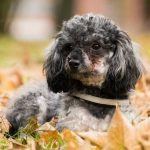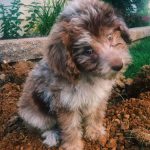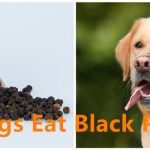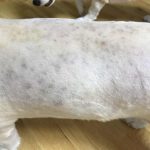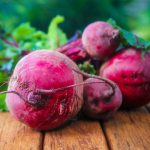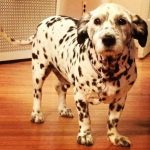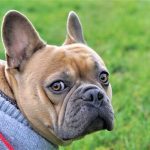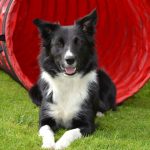Corn is rampantly used as filler in many kibble brands. Corn kernels, on the other hand, are safe for dogs in moderate amounts. Dogs can benefit from the essential fatty acids, natural antioxidants, and protein the corn kernels contain. If the kernels are okay for dogs, then how about a corn on the cob? Let’s take a look at the cob’s possible effects on a dog’s body.
Is It Safe for Dogs Eating Corn on the Cob?
Corn on the cob refers to freshly picked maize from the sweet corn cultivar. When you eat a corn on its cob, this means the cylindrical and woody part of the corn ear is still attached.
The cob does not get digested in a canine’s stomach so it can cause a blockage in his digestive system. Sadly, most pet owners are unaware that their dog ate a cob until the dog starts being sick. A cob may cause intestinal perforation which happens when it travels to the digestive tract or gets stuck somewhere on the tract.
A corn on the cob is deadly to dogs. Back in 2017, a dog named Saffy died one week after consuming a corn on the cob while on a walk with her owner.
The dog owner shared the story in a bid to raise awareness to dog parents, especially to those who had no idea about the dangers of corn on the cob represents for canines. This unfortunate event made the headlines and was shared thousands of times on social media.
In Saffy’s case, it took seven days before she started throwing up really bad. The pet owners assumed the dog had been poisoned so they brought her to the vet immediately.
The vets said they felt something hard in the poor dog’s stomach. They learned through a toxicity report that the vomiting was not due to any poisonous substance, but due to the cob that had lodged in the stomach.
Sadly, the cob had already made its way to Saffy’s intestines. This caused bleeding and the puppy died just a day after.
While it’s true that intestinal obstruction can kill a dog, it does not mean there is no way to save your dog if it happens to him. In 2016, a Rodesian Ridgeback named Sam luckily survived after the husk of a corn cob got stuck in his small intestine.
Similar to what happened to Saffy, Sam swallowed the husk while he was out walking with his owner. Likewise, the owner only learned about this after a series of X-rays showing the husk in the dog’s gut. Sam’s life was saved after a surgery.
Max, a puppy from Glasgow luckily survived after ingesting as much as six corn cobs. He threw up five of the husks but the last one got stuck in his digestive system. He underwent a major surgery in an emergency hospital in Glasgow.
The People’s Dispensary for Sick Animals (PDSA) revealed that a corn on its cob is among the most common items they removed from pets back in 2015, a year before Sam was brought there. PDSA, a veterinary charity in the U.K., said they treated around 28 cases of corn on the cob ingestion that year.
Signs of Foreign Body Obstruction in Canines
Just like in Saffy’s case, it may take as long as a week before any warning signs occur. Most of the time, however, the blockage can occur 1-4 days after the dog ate the corn cob. Here are the symptoms of a foreign body obstruction to keep an eye on:
- Vomiting – your dog will continue to vomit as long as the cob is inside his body. Dogs usually do well with fluids when vomiting. Offer a spoonful of water if he has not vomited for four hours.
- Inappetence – some dogs don’t have appetite and don’t want to eat anything. Some may even suffer from anorexia. You need to bring him to the vet if he can’t keep food down and if he continues to vomit.
- Dehydration – when a dog is dehydrated, vet surgeons will have to delay the surgery for 24 hours. The operating team will first stabilize a dog before proceeding with the surgery. An IV fluid is administered to prevent dehydration.
- Pain in the abdomen – a foreign object like a corn on the cob can cause abdominal pain in dogs. This is usually characterized by an abnormal posture or by signs of agitation.
- Bowel movement problems – while some pups experience diarrhea, some may not have a bowel movement at all. If your dog has not defecated for a couple of days, it is possible that something is wrong inside his body.
- Weakness and lethargy – there must be something wrong if your usually energetic dog just became lethargic all of a sudden. He might be crying out, yelping, or growling to express the pain. A blockage can make your pet uncomfortable.
What Will Happen When a Dog Ate a Corn on the Cob?
The American College of Veterinary Surgeons highlighted the problems that can arise happen when a dog ingests a foreign body like a corn on the cob. Below are the factors that determine its effect on the body:
- The time the cob has been inside the body – the longer it is in the body, the more complications could appear. If the foreign object is in the dog’s body for more than a week, it may be rotting already and may have traveled to the intestines. It will be difficult to remove it via endoscopy because the cob is no longer firm.
- Location of the corn cob – A chest surgery will be necessary if the cob reaches the diaphragm. If it’s still in his stomach, the vet surgeon will conduct an emergency surgery to remove it. If the cob has already reached the intestines, the operation will be more strenuous.
- Degree of obstruction – since the core of a corn cob is quite hard, it can cut through a dog’s intestines and damage them as it moves through the bowel. If there is a part of the intestine that has been damaged, it might also be necessary to remove a portion of it. The foreign body can cause a severe case of sepsis, which can kill a dog due to the large number of bacteria present in the blood.
- Problems associated with it – if the foreign body is made of a potentially toxic substance, this could lead to more complications. Thankfully, corn itself is not toxic to dogs. Besides, dogs often eat discarded corn cobs that no longer have corn on them.
If you are sure your dog already ingested one, bring him to the nearest vet emergency hospital. You may call them so the staff could get ready as you are your way there. If you don’t have a pet emergency hospital nearby, take your dog to his vet ASAP so he could refer you to one.
Don’t wait for the dog to start showing symptoms like vomiting. A foreign object as big as a corn cob cannot pass back out. Bear in mind it is very easy to miss the symptoms because some dogs can still act normal even after ingesting a foreign body.
Diagnosing Foreign Body Obstruction in Dogs
A vet will carry out a series of examination to determine the status of the cob inside your dog’s body. In such cases, vets usually order X-rays for a dog. There are cases when routine radiographs are not capable of showing the cause of the clinical signs, so the vet may use a positive contrast radiograph.
Aside from radiographic tests, vets also perform blood examinations to see if there are other causes for the dog’s symptoms. This includes checking the dog’s complete blood count as well as the serum chemistry.
Treating Foreign Body Obstruction in Dogs
Surgical intervention is the only solution when your dog accidentally ingested a corn on the cob. Many specialists do not recommend an endoscopy, or removing the cob using a flexible endoscope. This is because it cannot provide the same relief as a surgical intervention.
An internist may attempt to perform an endoscopy, especially if he is confident that he can grab the foreign object quickly. If he cannot, the dog will still need to undergo surgery.
In order for the veterinary surgeons to have access to the cob, they have to perform a chest or thoracic surgery. In a few cases, opening the intestine or the stomach is required. Gastrostomy refers to opening the stomach while enterotomy refers to opening the intestine.
Forcing a dog to vomit up the corn cobs is quite risky. There are vets who administer an apomorphine injection in the vein to make a dog vomit. This can be effective if there are only bits of the cob in the dog’s digestive system. But if Fido swallowed the whole thing, this is not advisable. Nowadays, most vets strongly go against induced vomiting because the cob might get lodged in the dog’s esophagus.
An anesthesia medication will be given before the operation and your vet will also prescribe pain medications after the surgery. Like humans, dogs also need extra care after undergoing medical procedures.
If your dog just underwent a cob removal operation, make sure he has a comfortable place to rest at home. He also needs to eat easily digestible foods during this time, so you need to make an effort and prepare simple pureed meals for him.
Most vets offer an extra support to dogs by scheduling a couple of visits after the operation. You also need to take the dog back to the ER if he is vomiting or experiencing diarrhea after the removal of the cob.
Conclusion
A corn on the cob is not safe for dogs. It can cause life-threatening complications such as gastrointestinal obstruction and perforation. If you have corn on the cob at home, make sure to dispose of the cobs properly. Corn on the cob is very common at barbecue parties. Ensure that Fido will not consume the leftover cobs.
As Saffy’s owner warned, keep the corn on the cobs away from your dog. But accidents can occur no matter how careful pet parents are. Like what happened to Saffy and Sam, your dog could eat a corn on the cob during an outdoor walk. If this happens, bring him to an emergency clinic right away so he can receive the proper treatment.
This should be a lesson to pet parents to be extra vigilant when walking their pup. Based on the real stories above, dogs got those cobs during a walk with their owners. Scan the sidewalk and check if there’s anything there that your dog could eat, causing him harm.








